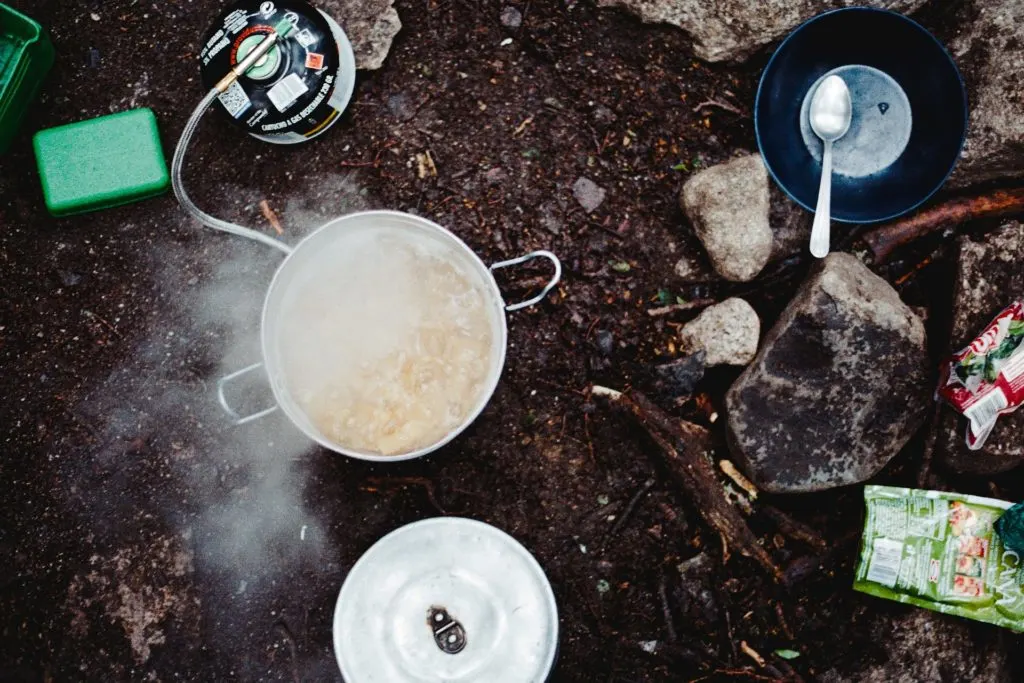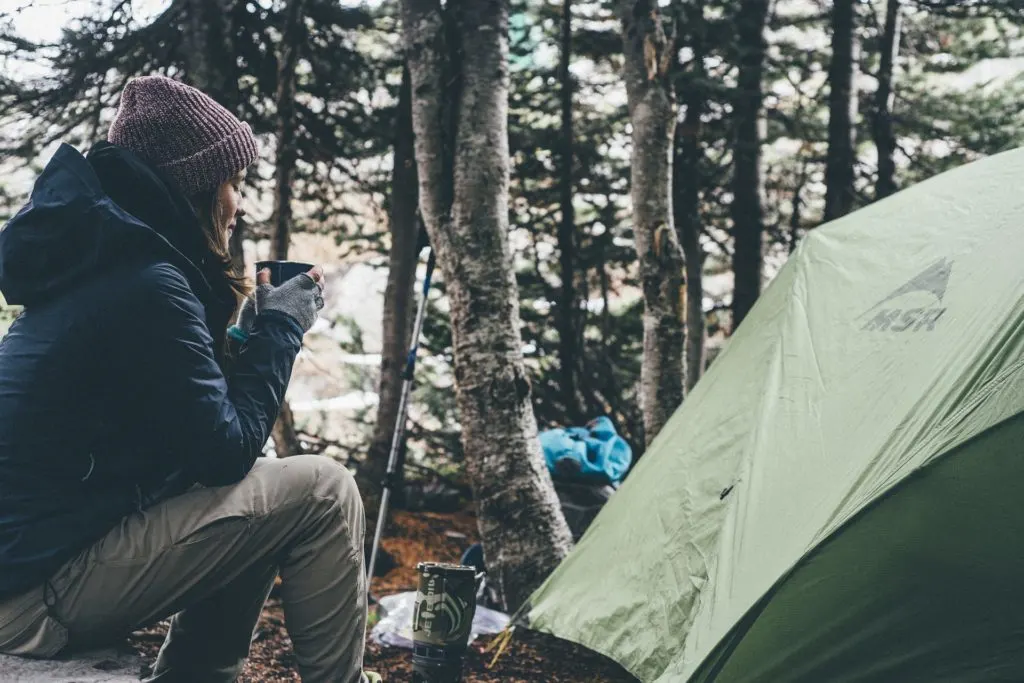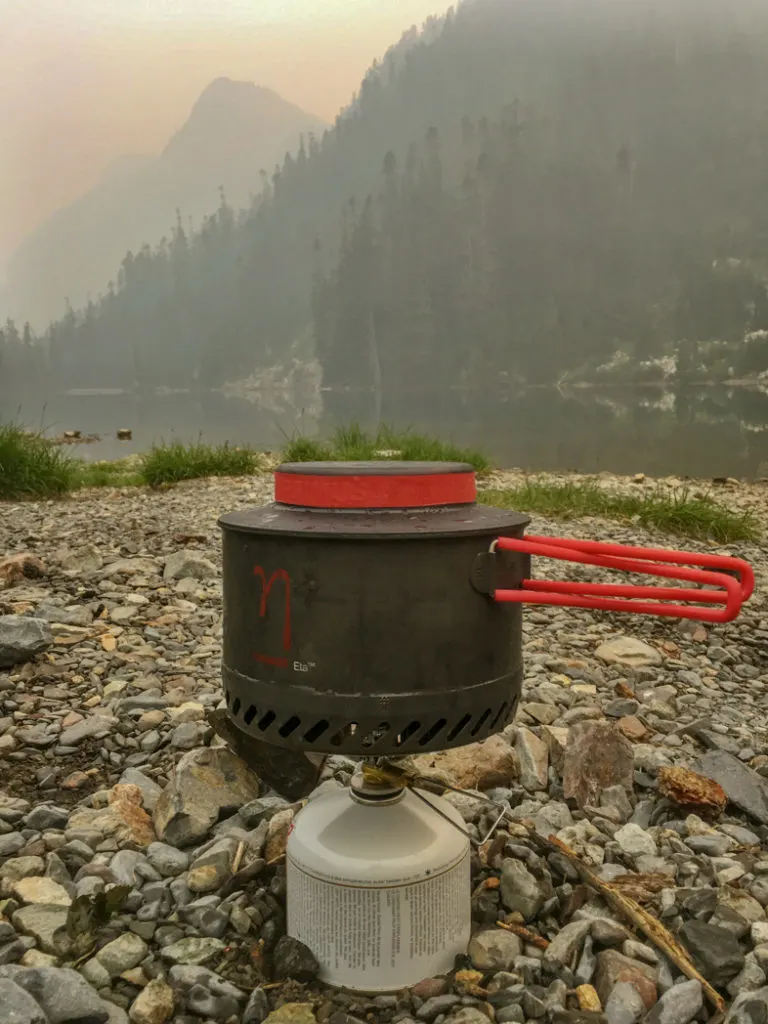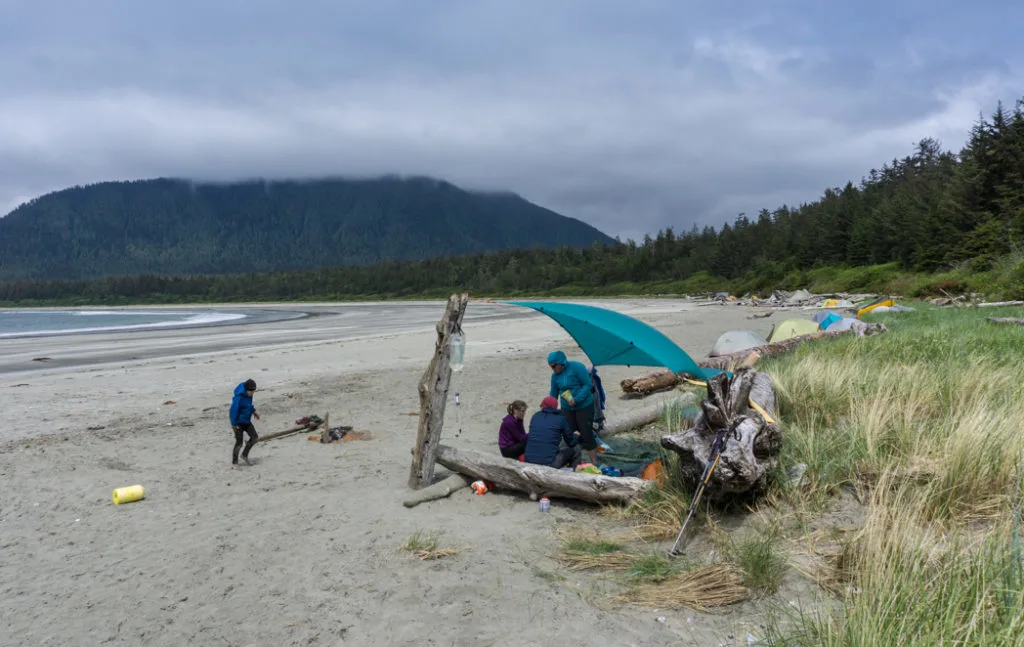There are so many moving parts to planning a backpacking trip: permits, weather forecasts, gear packing… And of course the meal plan. It can be tough to figure out what to eat in the backcountry. You’ll be exhausted at the end of the day and you want something delicious and filling. But how do you know what kind of food to choose? What makes a good backpacking meal? I’ve been experimenting with backpacking food for over a decade and through trial and error (so many errors) I’ve figured out what works for me. Here’s how to choose backpacking meals.
Hey there: Some of the links in this post are affiliate links, which means I earn a small commission at no extra cost to you. Thanks for supporting my website! -Taryn
Types of Backpacking Meals
First decide what kind of food you’re going to bring. There are a few types to choose from:
Canned Food
If you’re transitioning from drive-in camping to backpacking you might be tempted to take some of your campfire favourites like canned chili or Chunky Soup. Don’t do it! Canned food is really heavy (since it contains a lot of water), plus then you have to pack out the empty (and messy!) cans.
Fresh Food
Fresh fruit, vegetables and meat are tempting, but without access to refrigeration in the backcountry, they go bad quickly. Gourmet backpackers could try freezing ingredients at home, and then cooking them after they’ve thawed on the hike in. This method yields some delicious dinners but doesn’t work past the first night unless you are backpacking in very cold temperatures. Plus fresh food also tends to be full of water and very heavy.
Grocery Store Dry Goods
With a bit of planning, its easy to put together backpacking meals using shelf-stable foods you can find at the grocery store. These meals typically revolve around dried starches like noodles, rice or quinoa. You can even find prepackaged meals that include a powdered sauce mix from Kraft or Knorr.
I’ve also got a whole guide to making cheap backpacking meals using grocery store ingredients.
Home Dehydrated Meals
If you are willing to put in a bit of work, you can dehydrate your own backpacking meals at home using a home dehydrator or even your oven on low heat. The possibilities for home dehydrating are limitless, but it does take a bit of practice to get the recipes right and a lot of time to make and dehydrate the meals.
I’ve been home dehydrating my backpacking food for years, but since it’s so time consuming, I don’t make all of my own backpacking meals. My strategy is to make a curry, stew, or some delicious risotto at home, then dehydrate a few portions to take backpacking with me. (I have a simple Nesco Snackmaster food dehydrator that costs less than $75.)
READ NEXT: Dehydrating Food For Backpacking: A Beginner’s Guide
Prepackaged Backpacking Meals
There are tons of options out there for prepackaged backpacking meals. Popular brands include Mountain House, Good-to-Go, Backpacker’s Pantry and AlpineAire. These meals are either freeze-dried or dehydrated to remove the water, make them more compact and ensure they don’t go bad. To “cook” them you just add boiling water then let them sit for a few minutes. (Check the directions on your package as the amount of water and the wait time vary per meal.) In the past a lot of prepackaged meals were (honestly) really disgusting, but in recent years they’ve gotten better and most of them are pretty tasty. Some of them are even delicious. They are lightweight, fairly compact, and really convenient, but they can be expensive. As well, you’ll have to order them online or go to an outdoor store to buy them.
READ NEXT: Beyond Oatmeal: 6 Hot Backpacking Breakfasts
What Makes a Good Backpacking Meal?
My recipe for success? Choose backpacking meals that meet these criteria:
Tastes Good
Obviously, you want to pack food that tastes good. There’s nothing worse than carrying around food that you hate eating. Pick dishes that you know you like at home. If you’re cooking as a group, be sure to keep in mind the taste preferences of your group members. (Maybe that spicy beef chili isn’t the best choice for your hot-pepper-hating vegetarian friend?) If you’re buying prepackaged backpacking meals be sure to read the reviews to find out if they’re any good.
Fills You Up
You will burn a lot of calories hiking so you may want to pack more calories than you usually eat home. (You may find you want up to twice as many calories as usual!) If you’re buying prepackaged freeze-dried or dehydrated meals, be sure to read the labels carefully. Many claim to serve two people, but in reality only provide a few hundred calories per serving! That’s not enough! Hungry hikers often plan to eat a whole pouch themselves, or to add in extras to make their meals go further.
Keeps You Healthy
Have a look at the nutrition label when choosing backpacking food. Ensure that it has enough protein, fat and carbohydrates to meet your dietary needs. Most freeze-dried meals are heavy on the carbs (think pasta and rice) but low on protein and fat. Typical backpacking meals have a lot of sodium since you lose a lot of salt while sweating and also because it can help bland food taste better. If you can’t tolerate a lot of salt, real the labels on backpacking food carefully to check for sodium levels.
Doesn’t Weigh a Lot
When you’re carrying everything on your back, weight and bulk are a big factor in meal planning. The best meals have a high calorie to weight ratio and don’t take up a lot of space. Freeze-dried and dehydrated meals are ideal since they don’t contain any water, and water is heavy. If you’re putting together your own meals, choose dry ingredients where possible and repackage food into resealable ziploc bags to minimize packaging. Don’t forget to label the bags and include cooking directions.
Easy to Cook
When you’re cooking in the backcountry, the simplest meals are often the best. One pot meals with few cooking steps or just-add-boiling-water dinners save time and hassle around camp. Plus they make clean up much easier! More adventurous backcountry chefs might like bringing multiple pots or experimenting with baking, but for most of us, easy meals are best.
Cooks Quickly
The ideal backpacking meal is one that cooks quickly so it uses less fuel. It’s no use to have the lightest meal ever but then use tons of fuel trying to cook it: fuel is heavy! Just-add-boiling-water meals are the most fuel efficient. But check the labels: some just-add-water meals take a long time to rehydrate (up to 20 minutes!) and the food can get cold while you wait.
Isn’t Too Expensive
Just like most backpacking gear, you can pay a lot to save weight when it comes to backpacking meals. Most prepackaged backpacking dinners cost $8-12 and that can get expensive. You’ll have to decide for yourself if the convenience and light weight of packaged meals is worth it.
Customized For Your Tastes
No matter which type of meal you choose, from prepackaged freeze-dried, to home dehydrated to grocery store noodles, your meal will taste better if you customize it and have it just the way you like it. Here are some dinner add-in ideas:
Proteins and Fats: Beef jerky, cured sausage, bacon bits, hard cheese like parmesan, TVP (textured vegetable protein made from soy), foil pouch tuna, nuts and seeds, olive oil.
Sauces: soy sauce, hot sauce, mustard, pesto, ketchup, barbecue sauce, honey, mayo, powdered sauce mixes like alfredo or gravy. Tip: Pack liquid sauces in a mini tube (I like the silicone GoToobs) or save packets from take-out dinners and fast food outlets.
Spices and Flavourings: salt, pepper, chili flakes, curry powder, garlic, paprika, etc.
READ NEXT: Backcountry Chocolate Fondue Recipe
My Go-To Backpacking Dinners
When possible I home dehydrate my own backpacking food. That way I can ensure that the flavour is exactly how I like it and the serving sizes are large enough. However, home dehydrating is time consuming so sometimes I put together a quick grocery store meal or go with the convenience of a prepackaged meal. Here are my favourites. (Somehow they are all pasta… weird.)
Grocery Store Dry Goods: Pasta with Pesto Sauce and Salami
It’s not the lightest dinner, but my favourite grocery store backpacking dinner is really simple: pasta with pesto sauce and cured sausage or salami. At home package the dry pasta in a ziploc bag. Transfer the pesto into a squeeze tube (like a GoToob). Cut up the salami into 1/2″ chunks and package in a ziploc. At camp boil the pasta until al dente. Drain the water. Add the pesto and salami to the pot and saute for 1-2 minutes to warm up the meat and sauce.
Looking for more grocery store backpacking recipes? There’s more in my guide to making backpacking meals with grocery store ingredients.
Home Dehydrated: Zucchini noodles with Spaghetti Sauce
One of my favourite things to dehydrate at home is meat sauce with zucchini noodles. You could just serve the sauce with regular noodles, but I like the added serving of vegetables you get from the zucchini noodles. I make a simple spaghetti sauce with lean ground beef, onions and mushrooms. I spread it on my dehydrator trays and dry it until it is the consistency of really chewy fruit leather, then store it in ziploc bags. Since it has meat in it, I try use it within a few weeks of drying it. I use a spiralizer to make the zucchini noodles, then dehydrate them and pack them in a ziploc.
When backpacking, I add a bit of water to each bag as soon as I get to camp and let the dehydrated sauce and noodles rehydrate for a few hours. I check on it a few times and add more water if needed. When its time to eat, drain any excess water off the noodles, put the contents of both bags in a pot, then warm them up.

Prepackaged Backpacking Meals: Mountain House Lasagna with Meat Sauce
By far my favourite prepackaged backpacking meal is the Mountain House Lasagna with Meat Sauce. I’m not sure how they do it, but the cheese gets all melty and delicious. But don’t go in expecting a neat square of lasagna straight out of the pan. This is more of a deconstructed lasagna: it’s little square noodles with red sauce, ground beef and cheese.
Backpacking Recipe Resources
There are tons of resources out there for finding recipes and choosing backpacking meals. I often use websites or books for ideas, then adapt recipes to suit my needs. Here are some of my favourites.
Websites:
- Fresh Off the Grid – A beautiful site with tons of camping recipes and a smaller backpacking recipe section.
- Must Hike Must Eat – If you’re paleo, gluten-free, soy-free, dairy-free or nightshade free, you’ll love this site.
- Andrew Skurka – Lightweight and high calorie recipes and backpacking food tips from an thru-hiker and ultralight backpacking guru.
- Trail Cooking – tons of recipes, most of which are just-add-boiling water
- Hiking Experts Reveal Their Favourite Backpacking Food on Outdoors With No Limits
Books:
- Leave No Crumbs by Rick Greenspan and Hal Kahn – Great recipes for gourmet backpacking food with many recipes that can be dehydrated at home. The authors have a fun sense of humor too!
- Lipsmackin’ Backpackin’ by Christine and Tim Conners – A mix of simple and more complex recipes for the trail. Most use ingredients you can find at a normal grocery store. Plus the nutritional info and weight is given for each serving.
- Lipsmackin’ Vegetarian Backpackin’ by Christine and Tim Conners – Just like the regular Lipsmackin’ book, but with only veggie recipes. Non-vegetarians will still enjoy these meatless recipes.
More Backpacking Food Posts:
- Grocery Store Backpacking Meals for Cheap
- Dehydrating Food For Backpacking: A Beginner’s Guide
- Beyond Oatmeal: 6 Hot Backpacking Breakfasts
- Dehydrated Mushroom Risotto For Backpacking
- Backcountry Chocolate Fondue Recipe
More Backpacking Advice:
- Backpacking Checklist: Gear You Need To Go Backpacking
- Backpacking for Beginners: Tips for Getting Started
- 17 Ways to Save Money on Hiking Gear
- Bear Safety for Hikers, Campers and Backpackers
- The 10 Essentials: Things You Should Bring on Every Hike
What’s your favourite backpacking dinner? What criteria do you use to choose backpacking meals? Let me know in the comments.
- 10 Things to Do in Penticton in Summer - July 16, 2025
- Lake O’Hara Packing Lists for Hikers and Campers - April 25, 2025
- BC Parks Day Passes 2025 – Everything You Need to Know - April 24, 2025






Monica Sharma
Tuesday 28th of August 2018
Helpful post. I would like to follow your tips as I love to go on an adventurous trip and this post is very helpful to me so that I can pack the meals accordingly. Keep sharing such useful posts with the readers.
Kathi
Saturday 25th of August 2018
Backpacking meals are doing my head in - I'm vegan on top of everything and finding ready-meals without egg or milk powder in the UK is so hard! I love the idea of dehydrating food myself though - if only it wouldn't take so long... I ended up eating a lot of the same meals on my recent 2-week trek...
Cat
Saturday 25th of August 2018
Such a useful post! My go to is also pesto pasta :) i never thought of dehydrating my own food but i think it sounds like a great option!
Suzy
Friday 24th of August 2018
Great write up! We used to take those expensive hiking dinner packs but at US$15 each they are really expensive! Thought they are pretty tasty - the 'just add water' cheesecake is insanely good!! Nowadays we just take those pasta sachets and cured meats like you suggested. I've not tried to dehydrate zucchini before though, good tip - going to try that soon!
Shannon
Thursday 23rd of August 2018
Thank you for the shout out, Taryn and what a great post! My latest favorite meal on trail is Pad Thai and my criteria for meals is that they have to be extra flavorful (spicy, tangy, salty). Otherwise, I find I won't eat them. Oh, and that pick of the Wild Side Trail looks beautiful. I'm going to have to add it to my list!